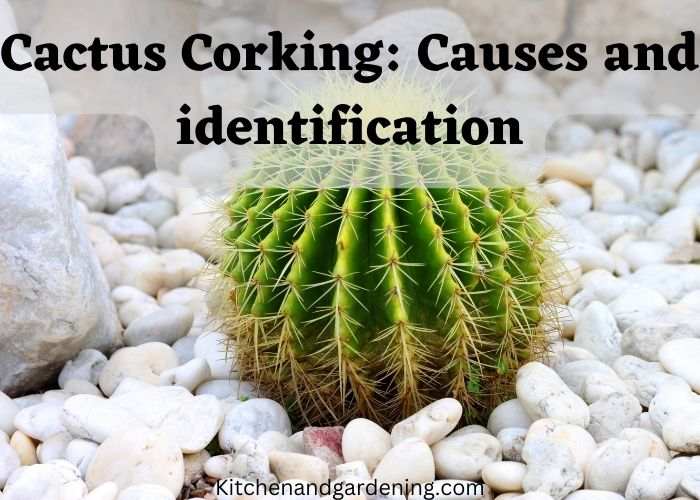Are your cacti turning brown? And the browning of the cactus started from the base of the plant? If the answer to both questions is yes, you’re at the right place!
Your cactus is corking, but don’t panic; read further to know the corking in detail.
First, let me be clear about the cactus corking. It is nothing but the turning brown of a healthy cactus plant. Brown bark-like tissue starts appearing from the base of the plant and moves up.
There is nothing to worry about because it is the aging part of the typical cactus plant.
Table of Contents
WHAT CAUSES CORKING

As cacti stay alive for many years and are succulent. They store moisture and stay healthy for even years. This moisture also makes the cactus heavy, in some cases, makes it break. But the surviving ones began corking to help support the stem and be stable.
Besides aging, corking can also result from long sun exposure, frigid temperatures, and high humidity. It appears as the brown scars on the stem of the cactus.
But let’s talk about the corking from the aging perspective.
The cactus corking starts from the base because the base supports the cactus plant. When the base becomes wooden textured, it becomes strong enough to bear the weight of the moisture plant stores.
The cactus remains alive, healthy, and greener for years before turning brown. But it solely depends on the species it belongs to. A few grow faster than others.
Did you know? Cactus grow from 1-3cm per year to 15cm yearly, depending on the species.
HOW TO IDENTIFY CORKING CACTUS?
Corking takes time. As the cactus grows progressively year by year, corking also takes years. This is not like an overnight process, one day, your plant is healthier, and the next day it starts turning brown: no!
You can identify corking by observing the base of your cactus plant keenly. The base starts turning bark-like when it is corked.
It’s not like the whole plant will get corked at once. The base starts turning brown and hard and moves up gradually.
Remember: If your plant is getting brown patches all over it, it is not corking; it is something else.
Once your cactus’ base has turned bark-like brown, it will eventually increase towards the upper part of the plant. A few species get it a few inches above the base. While others may get it progressively toward the top of the plant.
Sometimes, it’s not corking that has caused the cork cactus; it is the prolonged sun exposure. It mostly happens with cactus plants previously raised in the greenhouse or indoors.
Although succulents, including cacti, love sunlight, they should not be exposed to direct sunlight after a long break. If you have been protecting your succulent from extreme weather for a few months, don’t just directly place it under the sun one day.
If you do so, several brown patches will appear on the plant after a few days.
Tip: Start exposing it to indirect sunlight sources before making it strong enough to bear sunlight directly.
Plant care applications can also help to identify about corking cactus.
TREATMENTS OF CACTUS CORKING
Although there is no treatment for corking cactus, but a little you can do to make the process slower and keep it alive.
Once you know the cactus is corking, you should start taking care of the cactus plant more.
You should take care of the sunlight periods a day and its watering.
Let the soil dry completely before watering it again.
Do not move the plant repeatedly; let it rest in the same place for a long.
Protect the corking plant from frost because it can ultimately damage the cactus.
Also, keep an eye on the pests and damage due to rotting. If something such happens, treat it immediately.
You may also repot the cactus if the roots are compact.
CAN YOU PREVENT CACTUS CORKING?
Cactus corking is neither a disease nor it is harmful to the plant. It is part of the healthy cactus plant as it ages. Corking occurs when the succulent roots are exposed to water for longer, causing them to become dead or discolored.
When you water the corking cactus plant, the roots cannot absorb the water. The result is the discoloration of the plant starting at the base leaving the corks ultimately.
You can prevent the corking by taking care of the plant like other maintainable plants. Watering and applying fertilizer in a balanced amount is the key to keeping your cactus plant greener for longer.
CACTUS CORKING VS ROT
Cork cactus is often confused with cactus rotting. But let’s make it clear today!
Cactus rotting
If a cactus is damaged for any reason, including water entering the plant’s wound or fungus. If the water stays inside for longer, it can cause the plant to be entirely damaged from the inside.
Cactus Corking
Corking happens when the cactus gets older. There is no exact time for all the cacti to cork. It may happen after 20 to 50 years or less than that, but most cacti face corking.
What is the difference between corking and rotting?
Also, to identify and differentiate between the corking and the rotten cactus, you can check the cactus by touching it.
Press the cactus stem (where it is brown); if it is still firm and does not break after applying a little pressure, it is corked.
But, if your finger gets in or is stinking, it is rotten.
CACTUS CORKING OR FUNGUS?
Corking happens when the cactus gets older. The browning of the cactus starts from the base of the plant and gradually moves up.
While during springtime, the cactus gets spots on its pads due to high humidity and warm temperatures. Increasing watering during spring can also rot the cactus, ultimately leading to its death.
WHAT TO DO WITH THE CORKED CACTUS?
You might be thinking about what to do with the corked cactus once you are sure it is cork and not anything else.
Here’re a few tips that can help.
- Firstly, if the corking is not that severe, you may leave the plant as it is. It may recover slowly.
- But if it’s not ignorable, cutting earlier can help. Cut the affected area before it starts growing roots and affecting the whole plant.
- Cutting and propagating the cactus leaves is an excellent idea to grow many plants from one. The propagation method has already been explained step by step in our detailed Cactus Etiolation guide.
- It would be best to know the age of your cactus plant to propagate it before it starts getting corked.
- If you cannot do the above, also cant repot it, you can ultimately get rid of the plant.
IS CORKING BAD FOR PLANTS?
Corking is not harmful or destructive to your cactus plant. If it is because of the age of the plant. Just consider it part of its lifecycle.
But you can control it by propagating it timely or trimming it. Corking can also be slowed down by taking care of the plant’s sunlight and balanced fertilizer.
The older the cacti get, the more likely they will be hardened and bark-like.
Remember: Don’t confuse fungal or sunlight damage with the corking. They are harmful and need treatment.
WRAP UP!
This article covers what corking is. It is the turning brown of a healthy cactus plant. Brown bark-like tissue starts appearing from the base of the plant and moves up.
Causes of corking include prolonged sun exposure, frigid temperatures, and high humidity.
How to identify and treat the corking cactus? You can identify corking by observing the base of your cactus plant keenly. The base starts turning bark-like when it is corked.
Treatment of the cactus includes taking care of the plant more. The other ways have also been described.
It also covers the prevention tips that can help you avoid corking in the future. The critical factor is balancing the water, sunlight, and fertilizer.
Do you have more questions related to the corking in cacti? Here are the answers to the frequently asked questions.
FREQUENTLY ASKED QUESTIONS
Will my cactus die of corking?
Maybe, maybe not. If the corking continues and moves up toward the upper part of the plant, it might get dead. But the cactus will stay brown as long as it survives.
Do all cactus cork?
Yes, it is true for the majority of cactus plants. But if your cactus stays in a moderate environment the whole year, the chances of corking reduce.
At what age does a cactus start corking
There is no exact time for all the cacti to cork. It may happen after 20 to 50 years or less than that, but most cacti face corking.
Can I reverse the process of cactus corking?
The short answer is no. Because once the corking process starts, it progresses and changes the whole cactus brown.
Why is my cactus turning brown in patches?
Corking does not happen as patches on the cactus body. If you observe patches all over the cactus, it might be due to cactus fungi or other diseases.














Leave a Reply